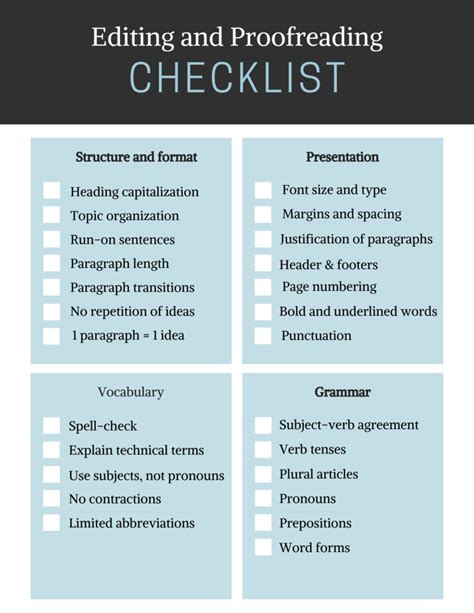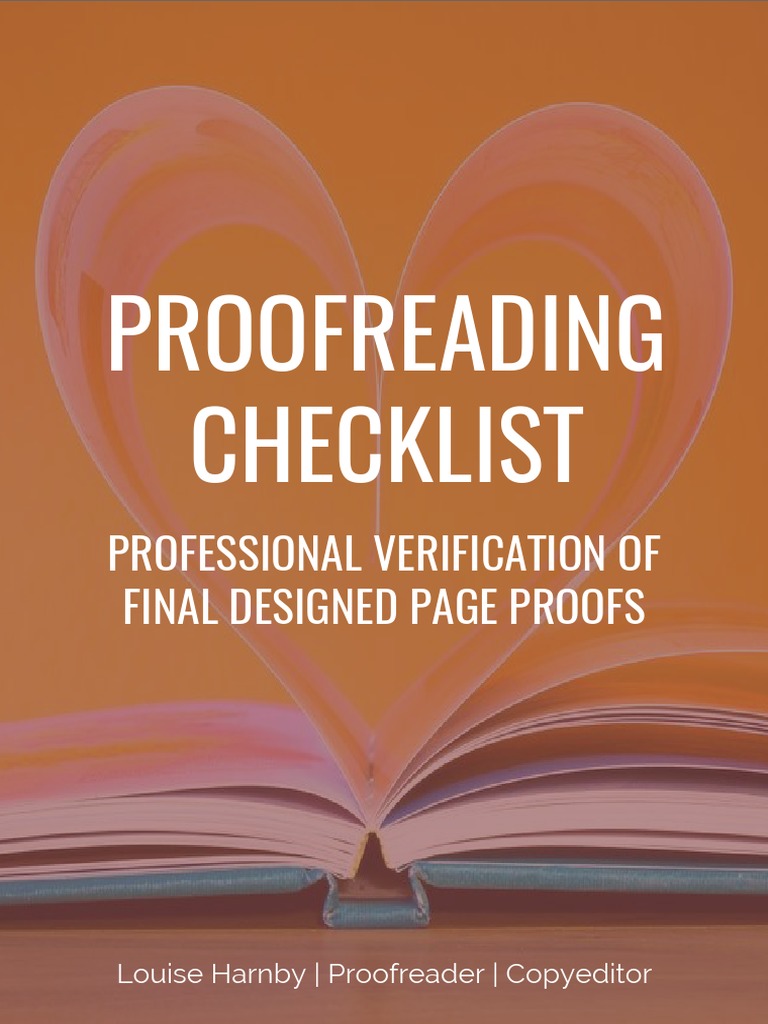Proofreading Checklist

In the world of writing and content creation, ensuring the highest quality and accuracy is paramount. Proofreading is an essential step in the editing process, helping to identify and rectify errors, inconsistencies, and ambiguities. This comprehensive guide aims to provide a meticulous proofreading checklist, offering a detailed framework for writers, editors, and content creators to achieve impeccable content. By following this expert-led checklist, you can guarantee that your work shines with precision and professionalism.
The Comprehensive Proofreading Checklist

Meticulous proofreading is a crucial aspect of the writing process, ensuring that your content is not only engaging but also free from errors and inconsistencies. This section provides an in-depth look at the essential elements to consider during the proofreading process, offering a detailed checklist to guide you through this critical phase of content creation.
Grammar and Syntax
The foundation of any written work lies in its grammar and syntax. Pay close attention to:
- Subject-Verb Agreement: Ensure that the verb agrees with its subject in terms of number and person.
- Pronoun Usage: Check for clarity and consistency in pronoun references.
- Tense Consistency: Maintain a consistent tense throughout the text, especially when referring to past, present, or future events.
- Parallelism: Ensure that elements in a series or comparison are grammatically parallel.
- Sentence Structure: Examine sentences for proper structure, avoiding run-ons, fragments, or awkward phrasing.
Punctuation and Capitalization
Punctuation and capitalization are vital for clarity and readability. Consider the following:
- Comma Usage: Review comma placement to ensure proper pauses and to avoid common errors like the comma splice.
- Apostrophes: Check for correct usage in contractions and possessives.
- Quotation Marks: Ensure proper placement for dialogue, titles, and direct quotes.
- Capitalization: Verify that proper nouns, titles, and the first word of sentences are capitalized appropriately.
- Hyphenation: Review hyphen usage, especially in compound adjectives.
Spelling and Word Choice
Accuracy in spelling and word choice is essential for maintaining a professional tone. Here’s what to look for:
- Spelling Errors: Utilize a spell checker, but also manually review for any potential errors, especially with homophones.
- Word Choice: Ensure that the language used is appropriate for the target audience and aligns with the tone and style of the content.
- Contextual Accuracy: Check that words are used correctly within the given context.
- Consistency: Maintain consistency in spelling, especially with British vs. American English variations.
Formatting and Layout
The visual presentation of your content is just as important as its textual elements. Consider these formatting aspects:
- Page Layout: Ensure a consistent and aesthetically pleasing layout, with proper margins, headings, and subheadings.
- Font and Typography: Verify that the chosen font is legible and consistent throughout the document.
- Headings and Subheadings: Check that they accurately reflect the content and are formatted consistently.
- Lists and Bullet Points: Review for proper formatting and consistency.
- Table Formatting: Ensure tables are clear, well-structured, and aligned with the text.
Fact-Checking and Accuracy
Maintaining factual accuracy is crucial, especially in informational or academic writing. Key points to verify include:
- Names and Titles: Ensure the correct spelling and titles for individuals, organizations, or institutions mentioned.
- Dates and Numbers: Verify accuracy and consistency in dates, times, and numerical data.
- Citations and References: Check that all sources are properly cited and referenced according to the required style guide.
- Research Integrity: Review any research or data included to ensure it is up-to-date and accurate.
- Contextual Accuracy: Ensure that the information presented is relevant and accurate within the given context.
Consistency and Flow
Consistency and a smooth flow of ideas are key to engaging and understandable content. Consider these aspects:
- Tone and Voice: Ensure that the tone and voice remain consistent throughout the piece, reflecting the intended style and audience.
- Transitions: Check that transitions between paragraphs and sections are logical and maintain a smooth flow of ideas.
- Repetition: Review for unnecessary repetition of words, phrases, or ideas.
- Pacing: Ensure that the content maintains a good pace, avoiding overly long sentences or paragraphs.
- Clarity: Verify that the content is clear and easy to understand, avoiding jargon or complex language where possible.
Visual Elements and Captions
If your content includes visual elements, ensure they are properly integrated:
- Image Placement: Check that images are placed appropriately and enhance the content.
- Captions and Alt Text: Ensure that captions accurately describe the image and that alt text is provided for accessibility.
- Image Credits: Verify that any required image credits or attributions are included.
Final Review
Before finalizing your content, take a step back and conduct a final review, focusing on the overall impression:
- Readability: Ensure the content is easy to read and understand, with a clear and logical flow.
- Engagement: Evaluate whether the content engages the reader and effectively communicates its message.
- Proofreading Tools: Utilize proofreading tools or services to catch any remaining errors or inconsistencies.
- Peer Review: Consider a peer review to gain fresh insights and catch potential errors.
- Editing Notes: Implement any necessary edits and ensure that all changes are properly documented.
The Benefits of Meticulous Proofreading

A meticulous proofreading process offers numerous advantages for content creators and their audiences. By implementing this comprehensive checklist, writers can ensure that their work is not only error-free but also engaging, clear, and professional. This level of attention to detail enhances the credibility of the content and the writer, fostering trust and respect within the target audience.
Future Trends in Proofreading
As technology advances, the field of proofreading is evolving. While tools like grammar checkers and AI-powered editors are becoming increasingly sophisticated, the human touch remains invaluable. The future of proofreading lies in a harmonious blend of technology and human expertise, where AI assists in identifying potential issues, and human editors apply their critical thinking and contextual understanding to ensure the highest level of accuracy and clarity.
Conclusion
In the world of content creation, proofreading is an indispensable step towards achieving excellence. By adhering to a meticulous proofreading checklist, writers and editors can ensure that their work meets the highest standards of accuracy, clarity, and professionalism. As the field continues to evolve, embracing technological advancements while maintaining the integrity of human expertise will be key to delivering impeccable content that resonates with audiences.
What are some common proofreading mistakes to avoid?
+Some common proofreading mistakes include overlooking homophone errors (e.g., “their” vs. “there”), incorrect comma usage, inconsistent verb tenses, and failure to check for factual accuracy, especially in citations and references.
How can I ensure a consistent tone and voice in my writing?
+To maintain a consistent tone and voice, create a style guide or reference document outlining the desired tone, language, and any specific terminology or phrasing. Review your content against this guide during the proofreading process.
What are some strategies for catching errors during proofreading?
+Strategies for effective proofreading include reading aloud, using text-to-speech tools, changing the font or background color of your document, or even printing a hard copy to review. These methods can help you approach your content from a fresh perspective, making it easier to spot errors.


